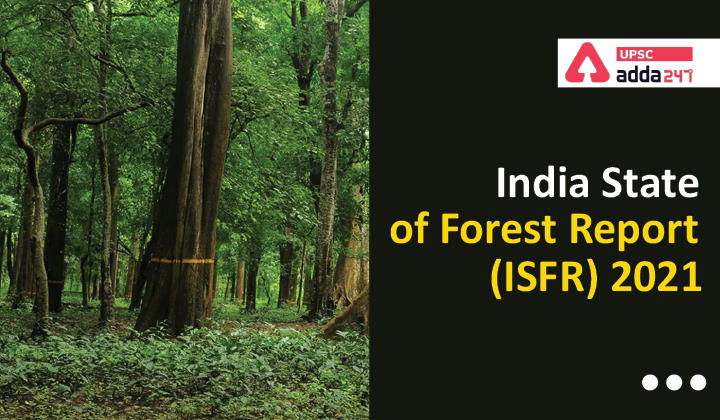Table of Contents
India State of Forest Report (ISFR) 2021- Relevance for UPSC Exam
- GS Paper 3: Environment- Conservation, environmental pollution and degradation.
India State of Forest Report (ISFR) 2021- Context
- India State of Forest Report (ISFR) 2021 was recently released by the Ministry of Environment, Forest and Climate Change (MoEFCC).
- The ISFR-2021 provides information on-
- Forest cover,
- Tree cover,
- Mangrove cover,
- Growing stock,
- Carbon stock in India’s forests,
- Forest fire monitoring,
- Forest cover in tiger reserve areas,
- Above ground estimates of biomass using SAR data &
- Climate change hotspots in Indian forests
Forest Conservation Act (FCA), 1980- Proposed Amendments to FCA
India State of Forest Report (ISFR)- Key Points
- About: India State of Forest Report (ISFR) is a biennial survey of India’s forests and tree resources. The First India State of Forest Report was published in 1987.
- Preparation: The India State of Forest Report is prepared by the Forest Survey of India (FSI), which has been mandated to assess the forest and tree resources of the country.
- India State of Forest Report (ISFR) 2021 is the 17th ISFR published by the Forest Survey of India (FSI).
- Significance:
- IFSR is widely used for formulating policies planning and management of forests as well as investments affecting the country’s forestry sector.
- IFSR also acts as an important reference document for students and researchers in the field of natural resource management.
- IFSR provides a significant amount of data that meets India’s reporting requirements to International Organizations and various conventions and commitments such as-
- Food and Agriculture Organization (FAO)
- UN Framework Convention on Climate Change (UNFCCC)
- Convention on Biological Diversity (CBD)
Red Sandalwood Falls Back into ‘Endangered’ Category
India State of Forest Report (ISFR) 2021- Major Findings
- Increase in total Forest and Tree Cover: As compared to the assessment of 2019 (ISFR-2019), there is an increase of 2,261 sq km in the total forest and tree cover of the country.
- Out of this, the increase in the forest cover has been observed as 1,540 sq km and that in tree cover is 721 sq km.
- The total forest and tree cover of the country is 80.9 million hectares which are 24.62 percent of the geographical area of the country.
- Increase in forest cover (Top States): Increase in forest cover has been observed in the open forest followed by very dense forests.
- As perISFR-2021, the top three states showing an increase in forest cover are-
- Andhra Pradesh (647 sq km)
- Telangana (632 sq km) and
- Odisha (537 sq km).
- Area-wise Forest Cover: ISFR 2021 reports that area-wise Madhya Pradesh has the largest forest cover in the country followed by Arunachal Pradesh, Chhattisgarh, Odisha and Maharashtra.
- Percentage-wise Forest Cover: In terms of forest cover as a percentage of total geographical area, the top five States are-
- Mizoram (84.53%),
- Arunachal Pradesh (79.33%),
- Meghalaya (76.00%),
- Manipur (74.34%) and
- Nagaland (73.90%).
- States/UTs with More than one-third area under forest cover: ISFR 2021 findings show that 17 states/UT’s have above 33 percent of the geographical area under forest cover.
- More than 75%: Five states/UTs namely Lakshadweep, Mizoram, Andaman & Nicobar Islands, Arunachal Pradesh and Meghalaya have more than 75 percent forest cover.
- Between 33%- 75%: 12 states/UTs namely Manipur, Nagaland, Tripura, Goa, Kerala, Sikkim, Uttarakhand, Chhattisgarh, Dadra & Nagar Haveli and Daman & Diu, Assam, Odisha, have forest cover between 33% to 75%.
- Increase in Mangrove cover: As per the India State of Forest Report (ISFR) 2021, an increase of 17 sq Km in mangrove cover has been observed as compared to the previous assessment of 2019.
- The total mangrove cover in the country is 4,992 sq km.
- Top three states showing mangrove cover increase are-
- Odisha (8 sq km)
- Maharashtra (4 sq km) and
- Karnataka (3 sq km).
- Total Carbon Stock: India State of Forest Report (ISFR) 2021 shows an increase of 79.4 million tonnes in the carbon stock of the country as compared to the last assessment of 2019.
- The annual increase in carbon stock is 39.7 million tonnes.
- The total Carbon Stock in the country’s forest is estimated to be 7,204 million tonnes.
- Bamboo Forests: As per ISFR 2021, Bamboo forests have grown from 13,882 million culms (stems) in 2019 to 53,336 million culms in 2021.
- Status of Forest Fires: India State of Forest Report (ISFR) 2021 findings show that 35.46% of the forest cover is prone to forest fires.
- Out of this, 2.81% is extremely prone, 7.85% is very highly prone and 11.51% is highly prone.
- Climate change hotspots in Indian forests: As per ISFR 2021, around 45-64% of Indian Forests will experience the negative impact of climate change and rising temperatures by 2030.
- Forests in all Indian states (except Assam, Meghalaya, Tripura and Nagaland) will be highly vulnerable climate hot spots.
- UT of Ladakh (forest cover 0.1-0.2%) is likely to be the most affected due to climate change and rising temperature.
- Forest cover in tiger reserve areas: IFSR 2021 included a new chapter related to the assessment of forest cover in the Tiger Reserves, Corridors and Lion conservation area of India.
- The overall decrease in forest cover across the 52 tiger reserves in the last decade has been 22.62 square kilometres (sq km).
- Some 20 of the 52 tiger reserves have shown an increasing trend.
- Top three Tiger Reserves showing increasing forest cover–
- Buxa (West Bengal)- 238.80 sq km
- Anamalai (Tamil Nadu)- 120.78 sq km and
- Indravati (Chhattisgarh)- 64.48 sq km
- The 32 remaining reserves have shown a declining trend, ranging from 0.06 sq km in Orang in Assam to 118.97 sq km in Kawal in Telangana.
- As perISFR-2021, the top three states showing an increase in forest cover are-
State of the World Trees Report




 TSPSC Group 1 Question Paper 2024, Downl...
TSPSC Group 1 Question Paper 2024, Downl...
 TSPSC Group 1 Answer key 2024 Out, Downl...
TSPSC Group 1 Answer key 2024 Out, Downl...
 Cabinet Ministers of India 2024, New Cab...
Cabinet Ministers of India 2024, New Cab...







